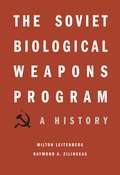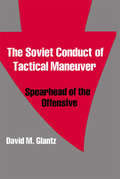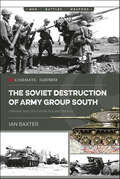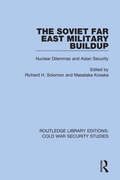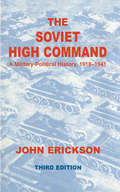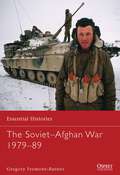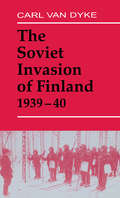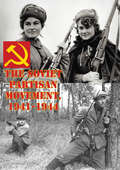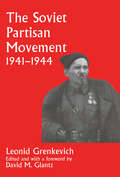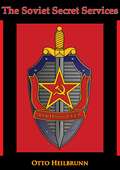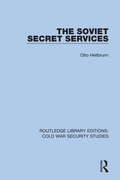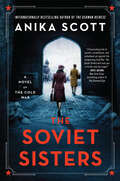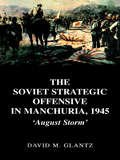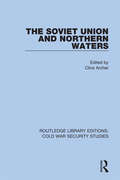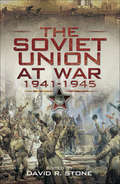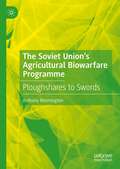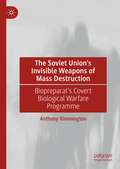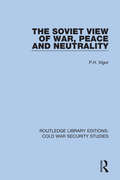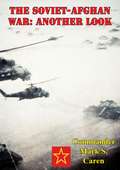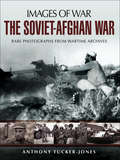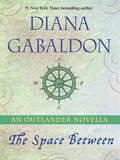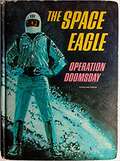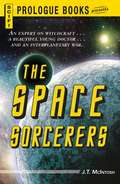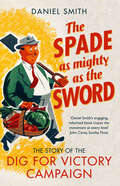- Table View
- List View
The Soviet Biological Weapons Program: A History
by Milton Leitenberg Raymond A Zilinskas Jens H KuhnThis is the first attempt to understand the full scope of the USSR’s offensive biological weapons research, from inception in the 1920s. Gorbachev tried to end the program, but the U.S. and U.K. never obtained clear evidence that he succeeded, raising the question whether the means for waging biological warfare could be present in Russia today.
The Soviet Conduct of Tactical Maneuver: Spearhead of the Offensive (Soviet (Russian) Military Theory and Practice)
by David GlantzFirst Published in 1991. Routledge is an imprint of Taylor & Francis, an informa company.
The Soviet Destruction of Army Group South: Ukraine and Southern Poland 1943–1945 (Casemate Illustrated #Cis0029)
by Ian BaxterA fully illustrated account of how the Third Reich’s Army Group South was defeated in 1944–forty-five by the Soviet Red Army.Following the destruction of Sixth Army at Stalingrad in February 1943, Army Group South slowly withdrew westwards, using the Dnieper as a fortified position. In late 1943, the Soviet 1st, 2nd, 3rd, and 4th Ukrainian Front launched a strategic offensive against the German Army Group South A—one of the largest operations of the war. In May 1944, Red Army troops defeated Army Group South and Army Group A on the Dnieper. Many thousands of German troops evacuated across the Black Sea. In July, troops of the 1st Ukrainian Front launched an operation into the Crimea. The offensive coincided with other Red Army operations further north, including the Lublin-Brest Offensive—part of Operation Bagration. Slowly and inexorably, the powerful Russian attacks forced the tattered German army group to retreat hundreds of miles west, into Eastern Poland and Romania. Here German forces defended their positions and built defenses in Hungary and Austria to try to slow down the overwhelming might of the Red Army. There, the Germans would fight a series of desperate battles until the remnants surrendered in early May 1945.Drawing on rare and previously unpublished images accompanied by detailed captions and text, the book gives a fascinating analysis of the destruction of Army Group South in southern Russia between 1944 and 1945.
The Soviet Far East Military Buildup: Nuclear Dilemmas and Asian Security (Routledge Library Editions: Cold War Security Studies #48)
by Richard H. Solomon; Masataka KosakaThis book, first published in 1986, examines the challenges the United States faced in maintaining a strong nuclear deterrence capability in the Far East without giving rise to political tensions among its allies. The Soviet aggression in the region, shown in the invasion of Afghanistan and the shooting down of a Korean airliner, demonstrated the need for a Western counterbalance, but the Asian nations were wary of becoming pawns in a nuclear power play between the superpowers. This book evaluates the meaning of Moscow’s military buildup in the global context; analyses the impact of the buildup from the perspective of China, Korea, Japan, the nations of ASEAN, Australia and New Zealand; explores the interaction of the buildup with the unresolved conflict on the Korean peninsula; and assesses the European experience with the Soviet nuclear threat and examines its implications for Asia. It also evaluates the linkages between European and Asian security.
The Soviet High Command: A Military Political History, 1918-1941
by John EricksonAn objective and documentary history of the earliest origins and formative years of the Workers-Peasants Red Army from the Civil War to the initial disasters of the war with Germany, the Great Patriotic War, culminating in the "battle for Moscow" in November-December 1941.
The Soviet Invasion of Afghanistan 1979-89
by Gregory BarnesThe Soviet invasion of neighbouring Afghanistan in December 1979 sparked a bloody nine-year conflict with the Mujahideen until Soviet forces withdrew in 1988-89, dooming the communist Afghanistan government to defeat by Afghan popular resistance backed by the USA and other powers. The Soviet invasion had enormous implications on the global stage; it prompted the US Senate to refuse to ratify the hard-won SALT II arms-limitation treaty, and the USA and 64 other countries boycotted the 1980 Moscow Summer Olympics. For Afghanistan, the invasion served to prolong the interminable civil war that pitted central government against the regions and faction against faction. The country remains locked in conflict over 30 years later, with no end in sight.For over a year before the invasion the communist Afghan government, installed following a coup and intent on forcibly modernizing the country's civil law in the face of centuries of feudal practices, had called for Soviet armed assistance in its efforts to overcome the open rebellion of the Mujahideen. Fearing the international consequences should the Afghan government be toppled, the Soviets decided to invade. From the outset, though, they failed to understand that communist principles were incompatible with traditional tribal relationships - especially in a country notorious for its poor communications and resistance to centralization.The Soviets found that their forces, largely made up of conscripts untrained in mountain warfare and counter-insurgency - and deploying 'conventional' weapons such as tanks and helicopters - could not defeat guerrillas enjoying the support of both the local population and powerful foreign allies such as the USA, and operating in harsh mountainous and/or desert terrain that favoured the defenders. The Soviets decided to stage a phased withdrawal of their own forces and concentrated on building up the Afghan government forces, but the Mujahideen soon prevailed, ushering in a new era dominated by the Taliban, an Islamist militia group that controlled large parts of the country from the mid-1990s.Featuring specially drawn mapping and drawing upon a wide range of sources, this succinct account explains the origins, history and consequences of the Soviet intervention in Afghanistan, thereby shedding new light on the more recent history - and prospects - of that troubled country.From the Trade Paperback edition.
The Soviet Invasion of Finland, 1939-40 (Soviet (Russian) Military Experience #No. 3)
by Carl Van DykeWestern accounts of the Soviet-Finnish war have been reliant on Western sources. Using Russian archival and previously classified secondary sources to document the experience of the Red Army in conflict with Finland, Carl Van Dyke offers a reassessment of the conflict.
The Soviet Partisan Movement, 1941-1944 (World War Ii Monographs #Vol. 211)
by Edgar M. HowellThe purpose of this text is to provide the Army with a factual account of the organization and operations of the Soviet resistance movement behind the German forces on the Eastern Front during World War II. This movement offers a particularly valuable case study, for it can be viewed both in relation to the German occupation in the Soviet Union and to the offensive and defensive operations of the Wehrmacht and the Red Army.The scope of the study includes an over-all picture of a quasi-military organization in relation to a larger conflict between two regular armies. It is not a study in partisan tactics, nor is it intended to be. German measures taken to combat the partisan movement are sketched in, but the story in large part remains that of an organization and how it operated. The German planning for the invasion of Russia is treated at some length because many of the circumstances which favored the rise and development of the movement had their bases in errors the Germans made in their initial planning. The operations of the Wehrmacht and the Red Army are likewise described in considerable detail as the backdrop against which the operations of the partisan units are projected.Because of the lack of reliable Soviet sources, the story has been told much as the Germans recorded it. German documents written during the course of World War II constitute the principal sources, but many survivors who had experience in Russia have made important contributions based upon their personal experience.
The Soviet Partisan Movement, 1941-1944: A Critical Historiographical Analysis (Soviet (Russian) Military Experience #No. 4)
by Leonid D. GrenkevichPartisans and terrorists have dominated military history during the second half of the 20th century. Leonid Grenkevich offers an account of the shadowy partisan struggle that accompanied the Soviet Union's Great Patriotic War (1941-1945).
The Soviet Secret Services
by Dr Otto HeilbrunnEspionage, subversion, infiltration, and sabotage are shown by an analysis of Soviet case material to be Soviet instruments of war. The author considers Soviet intelligence work in Germany in WWII to be a classic in espionage. He sees psychological warfare in all its aspects as a new usage of war. His fundamental position is that we must assess the Russian clandestine war potential, must be able to deal with it, and must ourselves be able to wage a war without battlefield.
The Soviet Secret Services (Routledge Library Editions: Cold War Security Studies #53)
by Otto HeilbrunnThis book, first published in 1956, analyses the Red Army’s strategic planning for a war involving nuclear weapons – whereby the front line is thinned out to protect it from nuclear attack and replaced by large-scale offensive operations in NATO’s rear. This new warfare technique had been successfully practised in WWII by Soviet partisan and guerrilla forces, and this book examines these foundations of Soviet secret services doctrine, and the principles by which they would operate.
The Soviet Sisters: A Novel of the Cold War
by Anika ScottFrom bestselling author of The German Heiress, a gripping new historical novel filled with secrets, lies, and betrayals, following two spy sisters during the Cold War."Anika Scott pens a fascinating tale of secrets, surveillance, and sisterhood.... The Soviet Sisters will suck you in to the very last page!" —Kate Quinn, New York Times bestselling author of The Diamond Eye“Electrifying, meticulously researched, and expertly plotted, The Soviet Sisters is at once a Cold War thriller, a gripping spy story, a page-turning mystery, and a familial drama.” —Lara Prescott, New York Times bestselling authorSisters Vera and Marya were brought up as good Soviets: obedient despite hardships of poverty and tragedy, committed to communist ideals, and loyal to Stalin. Several years after fighting on the Eastern front, both women find themselves deep in the mire of conflicts shaping a new world order in 1947 Berlin. When Marya, an interpreter, gets entangled in Vera’s cryptic web of deceit and betrayal, she must make desperate choices to survive—and protect those she loves.Nine years later, Marya is a prisoner in a Siberian work camp when Vera, a doyenne of the KGB, has cause to reopen her case file and investigate the facts behind her sister's conviction all those years ago in Berlin. As Vera retraces the steps that brought them both to that pivotal moment in 1947, she unravels unexpected truths and discoveries that call into question the very history the Soviets were working hard to cover up.Epic and intimate, layered and complex, The Soviet Sisters is a gripping story of spies, blackmail, and double, triple bluff. With her dexterous plotting and talent for teasing out moral ambiguity, Anika Scott expertly portrays a story about love, conflicting world views, and loyalty and betrayal between sisters.
The Soviet Strategic Offensive in Manchuria, 1945: 'August Storm' (Cass Series On Soviet (russian) Military Experience #Vol. 7)
by David GlantzThis critical examination of the final Soviet strategic offensive operation during World War II seeks to chip away at two generally inaccurate pictures many Westerners have of the war. Specifically, Westerners seem to think that only geography, climate, and sheer numbers negated German military skill and competency on the eastern front, a view that
The Soviet Union and Northern Waters (Routledge Library Editions: Cold War Security Studies #56)
by Clive ArcherThis book, first published in 1988, analyses the interests and activities of the Soviet Union in the northern Atlantic. It gives particular attention to the growth in exploration and exploitation of resources and to the problems presented by jurisdictional disputes. The responses of NATO, the United States and the Nordic countries to the expanded Soviet military presence are examined in detail.
The Soviet Union at War, 1941–1945
by David R. StoneHitlers invasion of the Soviet Union in 1941 precipitated a massive clash of arms that gave rise to destruction and suffering on an unprecedented scale. The outcome of this ruthless struggle on the Eastern Front was decisive for the course of the war in Europe. Yet the campaigns fought there still receive less attention than those fought by the Western Allies, and are less well understood. That is why this new survey of the Soviet Union during the Second World War, edited by David R. Stone, is so timely and significant.Stone has brought together a distinguished group of experts who give a penetrating reassessment of the Soviet war effort and economy. They offer a telling insight into the way in which enormous obstacles were overcome and sacrifices were made in order to achieve an overwhelming victory that changed the shape of Europe. Their wide-ranging analysis seeks to dispel myths and misperceptions that have distorted our understanding of the performance of the Red Army and the Soviet people.Editor David R. Stone is professor of history at Kansas State University. He is a leading authority on the military and political history of the Soviet Union in the 1920s and 1930s. As well as writing numerous journal articles, he is the author of two major studies: A Military History of Russia: From Ivan the Terrible to the War in Chechnya and Hammer and Rifle: The Militarization of the Soviet Union 1926–1933.
The Soviet Union’s Agricultural Biowarfare Programme: Ploughshares to Swords
by Anthony RimmingtonThis book focuses upon the secret agricultural biological warfare programme codenamed Ekologiya – which was pursued by the Soviet Union from 1958 through to the collapse of the USSR in 1991. It was the largest offensive agricultural biowarfare project the world has ever seen and Soviet anti-crop and anti-livestock weapons had the capability to inflict enormous damage on Western agriculture. Beginning in the early 1970s, there was a new focus within the Soviet agricultural biowarfare programme on molecular biology and the development of genetically modified agents. A key characteristic of the Ekologiya project was the creation of mobilization production facilities. These ostensibly civil manufacturing plants incorporated capacity for production of biowarfare agents in wartime emergency. During the 1990s-2000s, the counter-proliferation efforts undertaken by the US and UK played a major role in preventing the transfer of Ekologiya scientists, technologies and pathogens to Iran and other countries of potential proliferation concern.Anthony Rimmington is a former Senior Research Fellow at Birmingham University’s Centre for Russian, European and Eurasian Studies, UK. He has published widely on the civil life sciences sector in the post-Soviet states and on the Soviet Union’s offensive biological warfare programme, including Stalin’s Secret Weapon: The Origins of Soviet Biological Warfare.
The Soviet Union’s Invisible Weapons of Mass Destruction: Biopreparat's Covert Biological Warfare Programme
by Anthony RimmingtonThis book focuses on Biopreparat, the Soviet agency created in 1974, which spearheaded the largest and most sophisticated biological warfare programme the world has ever seen. At its height, Biopreparat employed more than 30,000 personnel and incorporated an enormous network embracing military-focused research institutes, design centres, biowarfare pilot facilities and dual-use production plants. The secret network pursued major offensive R&D programmes, which sought to use genetic engineering techniques to create microbial strains resistant to antibiotics and with wholly new and unexpected pathogenic properties. During the mid-1980s, Biopreparat increased in size and political importance and also emerged as a major civil biopharmaceutical player in the USSR. In the wake of the collapse of the Soviet Union in 1991, an acute struggle for control of Biopreparat’s most valuable assets took place and the network was eventually broken-up and control of its facilities transferred to a myriad of state agencies and private companies.
The Soviet View of War, Peace and Neutrality (Routledge Library Editions: Cold War Security Studies #57)
by P.H. VigorThis book, first published in 1975, analyses the three tools which the Russians used for attaining their political objectives: war, peace and neutrality. This study shows how they have evolved a clear-cut view, based on Marxism-Leninism, of the origins of war, the categories of war, the ways in which it can be made to serve the Marxist revolutionary interest, and the circumstances in which it is profitable to use it. As for peace, both Lenin and Khrushchev described it as a ‘temporary, unstable armistice between two wars’. In the Leninist view, peace is a tool for attaining political objectives just like war, while neutrality is essentially ridiculous: ‘he who is not with me is against me’. Nevertheless, there are occasions when neutrality is a concept acceptable to the Soviet leaders, and this study examines instances of this, alongside war and peace.
The Soviet-Afghan War: Another Look
by Commander Mark S. CarenThis research effort reviews the Soviet military's involvement in Afghanistan from four general, perspectives: (1) systemic problems inherent in the Soviet military culture, (2) the use of surprise, (3) operational maneuver and the preeminence of aviation and (4) employment of mines and chemical weapons as an extension of maneuver warfare. This paper concludes that the lessons of this war have been learned by the Russians. There is every reason to believe that they can achieve the level of doctrinal changes required to be successful in future "local" interventions. It must be accompanied, however, by corresponding socio-military reform.
The Soviet-Afghan War: Rare Photographs from Wartime Archives (Images of War)
by Anthony Tucker-JonesThis photographic history of the Soviet-Afghan War of 1979 to 1989 gives a fascinating insight into a grim conflict that prefigured the American-led campaign in that country. In an unequal struggle, the mujahedeen resisted for ten years, then triumphed over Moscow. For the Soviet Union, the futile intervention has been compared to the similar humiliation suffered by the United States in Vietnam. For the Afghans the victory was just one episode in the long history of their efforts to free their territory from the interference of foreign powers. By focusing on the Soviet use of heavy weaponry, Anthony Tucker-Jones shows the imbalance at the heart of a conflict in which the mechanized, industrial might of a super power was set against lightly armed partisans who became experts in infiltration tactics and ambushes. His work is a visual record of the tactics and the equipment the Soviets used to counter the resistance and protect vulnerable convoys.It also shows what this grueling conflict was like for the Soviet soldiers, the guerrilla fighters and the Afghan population, and it puts the present war in Afghanistan in a thought-provoking historical perspective.
The Space Between: An Outlander Novella (Outlander)
by Diana GabaldonNEW YORK TIMES BESTSELLERDiana Gabaldon returns to her Outlander universe in "The Space Between," an irresistible novella brimming with adventure, history, and suspense--and available for the first time as a standalone eBook. Features a preview of the much-anticipated new Outlander novel, Written in My Own Heart's Blood! Joan MacKimmie is on her way to Paris to take up her vocation as a nun. Yet her decision is less a matter of faith than fear, for Joan is plagued by mysterious voices that speak of the future, and by visions that mark those about to die. The sanctuary of the nunnery promises respite from these unwanted visitations . . . or so she prays. Her chaperone is Michael Murray, a young widower who, though he still mourns the death of his wife, finds himself powerfully drawn to his charge. But when the time-traveling Comte St. Germain learns of Joan's presence in Paris, and of her link to Claire Fraser--La Dame Blanche--Murray is drawn into a battle whose stakes are not merely the life but the very soul of the Scotswoman who, without even trying, has won his heart. Praise for Diana Gabaldon's Outlander series "A grand adventure written on a canvas that probes the heart, weighs the soul and measures the human spirit across [centuries]."--CNN, on The Fiery Cross "History comes deliciously alive on the page."--New York Daily News, on Outlander "Abounds with Gabaldon's sexy combination of humor, wild adventure and, underlying it all, the redemptive power of true love."--The Dallas Morning News, on The Fiery Cross "Gabaldon is a born storyteller. . . . The pages practically turn themselves."--The Arizona Republic, on Dragonfly in Amber "Wonderful . . . This is escapist historical fiction at its best."--San Antonio Express-News, on Drums of Autumn
The Space Sorcerers
by J. T. McintoshA sudden, savage, suicidal, senseless attack.Why are thousands of Tinkers ready, eager, and determined to die in an insane attack on their planetary neighbor, Shan?War consultant Ray Cottrell doesn't really care; a beautiful young playmate has just jumped into his lap, one of many in a long line. But when he realizes what's behind the Tinkers' suicide, he realizes he's going to have to step in.Because he alone can defeat the Space Sorcerers.
The Space Sorcerers
by J. T. McintoshA sudden, savage, suicidal, senseless attack.Why are thousands of Tinkers ready, eager, and determined to die in an insane attack on their planetary neighbor, Shan?War consultant Ray Cottrell doesn’t really care; a beautiful young playmate has just jumped into his lap, one of many in a long line. But when he realizes what’s behind the Tinkers’ suicide, he realizes he’s going to have to step in.Because he alone can defeat the Space Sorcerers.
The Spade as Mighty as the Sword: The Story of the Dig for Victory Campaign
by Daniel SmithThe little-known history of the “Garden Front”—Britain’s wildly successful vegetable-growing campaign during WWII: “A fascinating story.” —Northern EchoAfter food rationing was introduced in 1940, and German U-boats began threatening merchant shipping bringing in essential foodstuffs, the Ministry of Agriculture decided something had to be done to make the kitchens of Britain more self-sufficient.The result was an amazingly effective campaign—Dig for Victory—encouraging every man and woman to turn their garden, or even the grass verge in their street, over to cultivating vegetables. By 1942 half the population were taking part, and even the Royal Family had sacrificed their rose beds for growing onions.Now, Daniel Smith tells the full story of this remarkable wartime episode when spades, forks, and bean canes became weapons the ordinary citizen could take up against the enemy. It had tangible benefits for the war effort in that shipping could be reallocated for munitions instead of food imports, as well as for the health of the nation in encouraging a diet of fresh fruit and veg. The campaign also created unexpected celebrities like C.H. Middleton, whose wartime BBC radio talks on gardening reached a vast audience, and even sowed the seeds for the modern allotment movement.Ultimately it is a war story without fighting or killing, one that shows how even The Little Man with the Spade, in the words of the Minister for Agriculture at the time, did his bit for Victory.“Engaging.” —The Sunday Times“An inspirational account.” —Lancashire Evening Post
